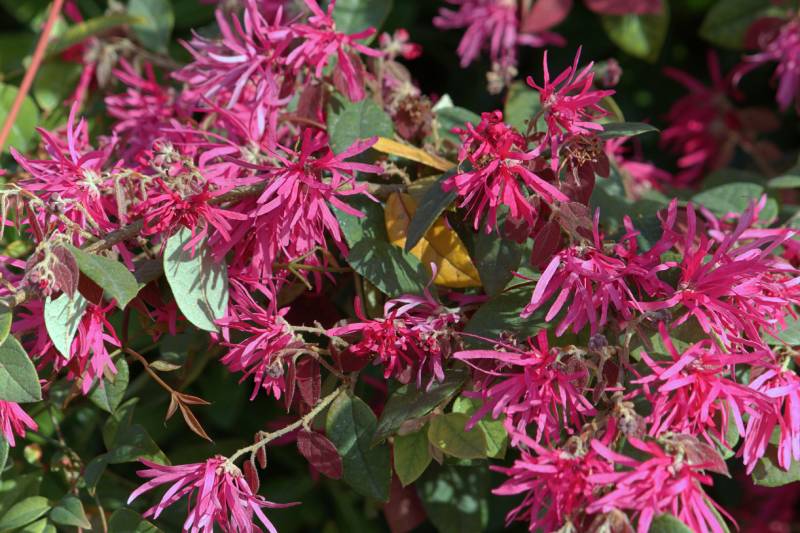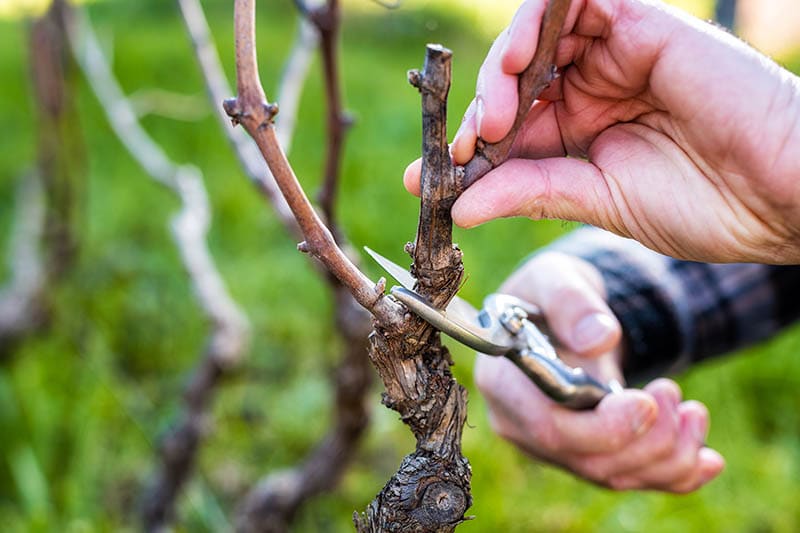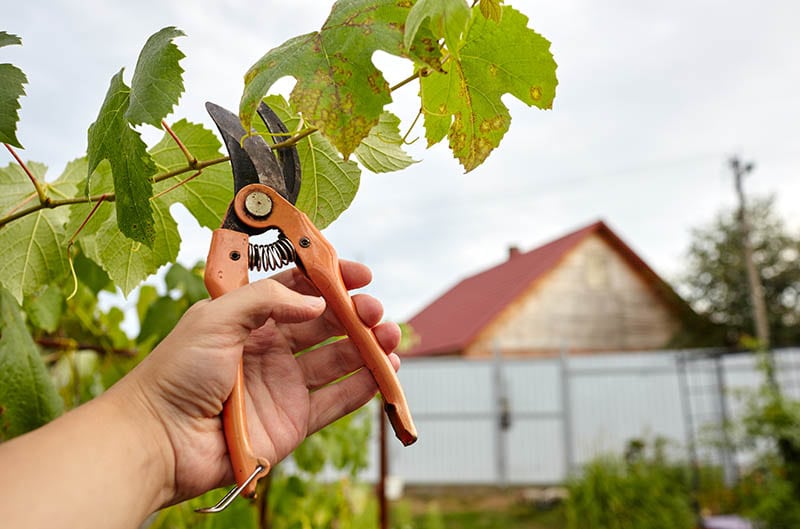8 Tips on When and How to Prune Loropetalum
-

- Last updated:

Commonly known as the Chinese fringe flower, this lovely evergreen shrub grows fast and blooms twice a year, producing beautiful, multi-colored blooms. It prefers partial shade, a warm climate, and well-drained soil. Loropetalum is a sturdy, low-maintenance plant. But to stimulate growth, keep the leaves and stems healthy, and keep bugs at bay, you do need to prune it.
This is a fairly straightforward process that will only take 15–30 minutes of your time. But how often do you have to do that? Is early spring a good time, or not? Maybe you should wait before the buds blossom or shear the shrub before it flourishes? How do you prune the Chinese fringe flower without damaging it? It’s time to find the answers!
| Common Name | Chinese fringe flower |
| Soil Type | Well-drained, moist, loamy, organically-rich |
| Soil PH | 6.0–7.0 (slightly acidic) |
| Sun Exposure | Sun/partial shade |
| Watering Requirements | Moderate (once in 1–2 weeks) |
| Maintenance | Minimal |
| Hardiness Zone | 7–10 USDA |
| Blooming cycles | February–March, summer |
What’s the Right Time for Pruning Loropetalum?
Most shrubs only need pruning once a year. However, with loropetalum, it’s recommended to do it every six months because it has two blooming cycles instead of one. The first one starts in winter (usually in late February). By early March, the Chinese fringe flower is covered in beautiful pinkish blossoms. As for the second cycle, it starts in early summer, right after the lush spring bloom.
So, does that mean loropetalum is to be pruned in the summer or winter? Well, not quite! If you want to stimulate steady growth and maximize the flowers, prune it in late spring to early summer, AFTER the first blooming cycle. True, that will have a negative effect on the shrub for the rest of the year and affect the summer cycle. On the bright side, next year, the spring season will be more opulent than ever!
The 8 Tips to Prune Loropetalum
1. Get the Tools for the Job

First, make sure you have the right equipment for the task. This will be largely dictated by what you’re trying to achieve with the pruning. Most gardeners want to keep growth under control; others are dealing with overgrown shrubs and need to cut them back in size. If you’ve got a branch or two that needs work, bypass pruning shears or hedge shears will be the perfect pick.
These tools are great for trimming any plant back to whatever size you need. A quick note: most shrubs out there are thick on the top yet not nearly as dense at the bottom. To avoid that, make the foundation a bit wider so that the base leaves get their fair share of the sun during the day and thrive. Again, use shears for that.
2. Be Very Gentle With It
Loropetalum has fragile, brittle branches. So, remember to NOT lean into the shrub when “working your magic” around it. Take it slow and be gentle with the cuts. Otherwise, you’ll end up breaking a branch or two before you realize it. This plant is a fast grower and doesn’t need much stimulation. Even if you do minimal pruning, that will have a big effect.
When it’s dense and thick next spring with hundreds of blooming flowers, loropetalum will instantly turn into a crowd-pleaser. If some of the leaves or stems are diseased, you can, of course, cut them out. But, again, apply very little force. The idea is to put minimal pressure on the branches while removing the unwanted parts or pruning some of the stems.
3. Thinning or Releadering?
When cutting out the damaged or dead parts of the shrub, go with thinning or releadering cuts. No matter how careful you are with the pruning, you’ll still be inflicting wounds onto the loropetalum. But this way, you’ll be able to get the job done swiftly while keeping the plant healthy. To shape the shrub, open it up, and stimulate new growth, go with thinning cuts and remove the branch at its origin.
And if you want to promote the lateral branch, releadering cuts will be preferable. This technique involves cutting a part of the branch out right at a “Y” junction, eliminating the dominant branch and making way for the lateral one. That won’t lead to accelerated growth. Instead, it will encourage the Chinese fringe flower to “change its direction” while reducing its density and making it a bit shorter.
4. Making the Cut

Now that you’ve got the tools ready and have decided between releadering and thinning, it’s time to make the cut. The name of the game here is precision. Make sure you’re cutting at a 45° angle, right above the leaves. By doing that, you’ll help the shrub heal (relatively) fast and stimulate the growth of new buds and blossoms.
Jugged cuts, in contrast, leave nasty marks on the branches that are hard to recover from. Are you happy with the way the pruned loropetalum looks? Then don’t forget to water it deeply. This will help the shrub heal more quickly. A thin layer of fertilizer will also be a good idea.
5. Pruning in Winter vs Summer
If you cut out an entire branch during the winter season, you’ll have to say goodbye to a whole lot of buds that grew last summer. And what will happen if you do this in late May after the blooming cycle is over? Cutting out a branch completely in springtime will slow down flower growth for the next year.
That’s because you’ll be removing parts of the plant that the second row of buds is supposed to grow on. Remember: you should always put the health of the plant first. If it’s taken over by pests/diseases, don’t wait for the next blooming season to cut the dead branches out. However, if you’re chasing aesthetic goals, it would be best to wait for late April or early May for that.
6. Why Prune Loropetalum?

Just like any other plant or shrub out there, the Chinese fringe flower tends to outgrow its container, pot, or garden bed. And pruning is the most effective tool in a gardener’s arsenal against that. Good news: if you’re not a big fan of pruning, you can pick a loropetalum species that will fit your desired size. True, this will take some time. It’s not always easy to figure out the right type of shrub for your garden.
But, when you do manage to find the right variety, you won’t have to do much pruning after that. Another reason to cut out big chunks of stems, branches, and leaves is to fight pests and diseases. Loropetalum is quite a sturdy and resilient plant but it is vulnerable to bacterial gall, Pseudocercospora, and various destructive bugs.
7. Shaping a Shrub/Hedge
This plant is highly “customizable”: you can prune it to get the shape that fits your garden or landscape the most. The list includes pyramid, square, poodle tier, and other shapes. We recommend using hedge shears or trimmers (preferably electric ones). These tools aid in shaping the plant to your liking without putting much effort into it.
Just make sure not to overdo it. We know it can be fun to experiment with different looks, but aggressive pruning might end up ruining the plant. Loropetalum simply won’t be able to recover from all the cutting and will wither or fade. As mentioned in the beginning, doing this twice a year is the golden rule—stick to it!
8. Converting a Shrub Into a Tree

Some loropetalums can reach 6–7 feet in height. You can use a pruning tool to turn them into lovely dwarf trees. To achieve this, it’s important to get rid of the lower branches of the plant. Most Chinese fringe flowers have 1–3 trunks, and it’s up to you to decide how many to keep around. Even if there’s one trunk, that will still work. Grab your trusted pruning shears or loppers.
They’ll make removing lateral branches an easy task. Do your best to cut as close to the trunk as possible yet not damage the actual trunk. Once the tree grows, new branches will follow. To maintain the health of the lorpetalum, use the same tools to get rid of them.
 Growing Loropetalum: A Quick Look
Growing Loropetalum: A Quick Look
There are several things that need to be considered when growing a loropetalum.
- Just like most shrubs, the Chinese fringe flower prefers well-drained yet moist soil. As for the pH, go for slightly acidic soil. This way, you’ll be able to stimulate fast growth without putting the plant in any danger. Loropetalum isn’t at all picky when it comes to the soil type but will benefit greatly if it’s loamy.
- We recommend fertilizing the shrub 2–3 times per year to keep the soil healthy and nutrient-rich. Use a granular, slow-release fertilizer (10–10–10) for the best results. On average, 1/4 cup of the product should be more than enough for this plant. Be careful not to disturb the roots while you’re fertilizing the soil.
- Loropetalum water requirements vary greatly depending on the season. For example, if you planted it in late fall/early winter, thorough watering once in 10–14 days will suffice. In contrast, Chinese fringe flowers planted in spring will only grow if you water them 3–4 times a week for 3–4 months while they’re still growing.
- Sun Exposure. Should you provide full exposure to the sun, or only partial? With this shrub, both scenarios will work. In fact, depending on the species, it might prefer partial sun more. Ideally, you should let it have morning sun for 2–3 hours and a bit of shade for the rest of the day. This is a drought- and heat-resistant plant, by the way.
Loropetalum Medical Use
The Chinese fringe flower has hemostatic and depurative properties. That’s why it’s often used to treat tuberculosis and infection of the intestines (dysentery, enteritis). You can make a decoction and use the loropetalum plant as a remedy. The leaves, in turn, heal external wounds.
Just make sure to pulverize them before application. Now, while this shrub isn’t nearly as powerful as traditional medicine, it can still numb the pain and fight infections. So, if you’re growing loropetalum in an outdoor garden or cultivating it in pots or containers indoors, keep these health benefits in mind.
Is Loropetalum Toxic to Pets?
The short answer is no, this flowering shrub is generally not toxic to dogs or cats. The same is true for humans (including children). With that said, if the four-legged member of your family swallows a whole plant, that might upset the stomach. It’s rich in tannins, compounds that can be harmful to animals and people. But a leaf or two won’t have any negative effects.
 Conclusion
Conclusion
When it comes to pruning, the biggest questions are when and how. This greatly depends on the plant. In most cases, a single pruning session once per year gets the job done. But sometimes, you need to do this 4–5 times to achieve the desired results. As for the Chinese fringe flower, it has two blooming seasons. That’s why you should prune it twice a year.
The main purpose of pruning is to cut out diseased or damaged leaves and branches to keep the plant healthy. Shaping the shrub and stimulating growth are also very important. Do this right after the spring bloom, and you’ll be rewarded with more blossoms than the garden can handle!
- Edu – Loropetalum
- Ucanr.Edu – Thinning and Releadering Cuts
- Edu – Loropetalum chinense – Fringe Flower
- When And How To Prune And Trim A Loropetalum Shrub Or Tree
- Edu – Key Plant, Key Pests: Chinese Fringe
- plantaddicts.com – When to Prune Loropetalum
- clemson.edu – LOROPETALUM
- Pubmed – Tannins And Human Health: A Review
- naturalmedicinalherbs.net – Loropetalum chinense
- plantaddicts.com – Watering Loropetalum
- ehow.com – Is Loropetalum Harmful?
Featured Image Credit: Carsten Schnoor, Shutterstock
Contents

 Growing Loropetalum: A Quick Look
Growing Loropetalum: A Quick Look